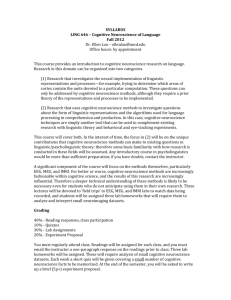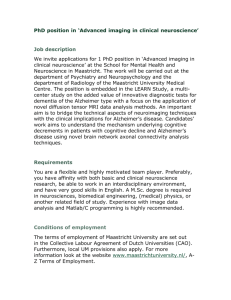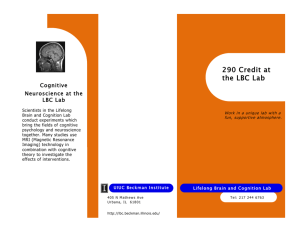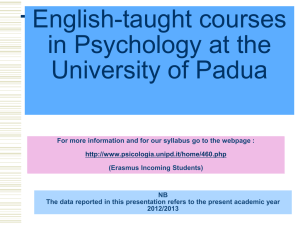Program: MA Analytic philosophy, year II Course title: Philosophy of
advertisement
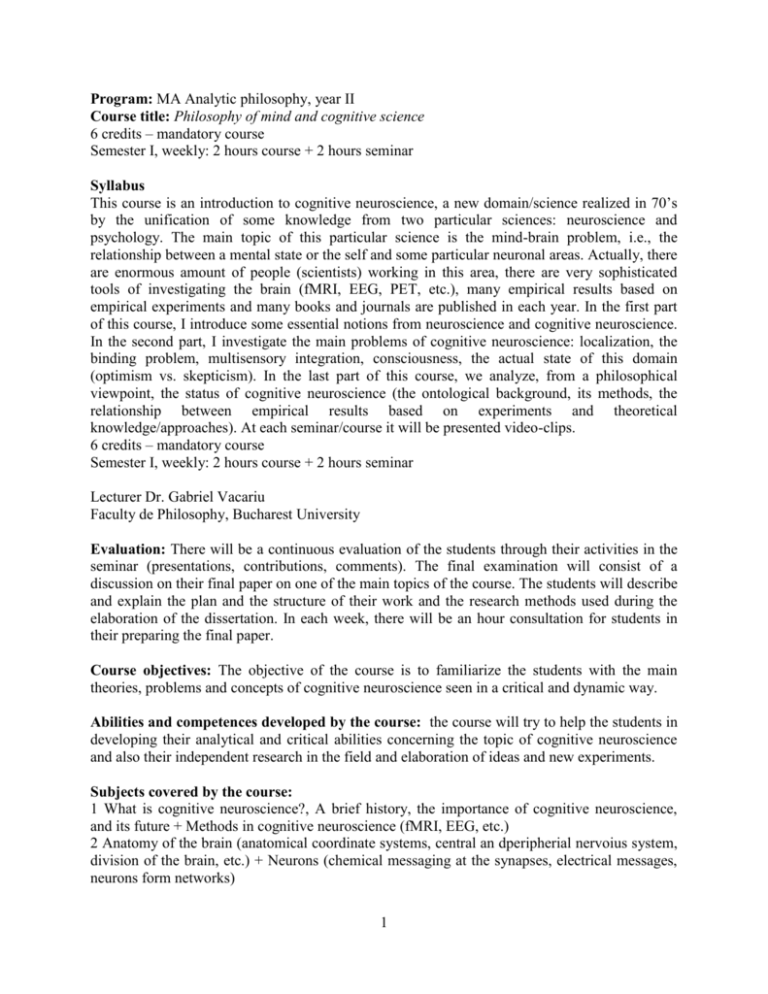
Program: MA Analytic philosophy, year II Course title: Philosophy of mind and cognitive science 6 credits – mandatory course Semester I, weekly: 2 hours course + 2 hours seminar Syllabus This course is an introduction to cognitive neuroscience, a new domain/science realized in 70’s by the unification of some knowledge from two particular sciences: neuroscience and psychology. The main topic of this particular science is the mind-brain problem, i.e., the relationship between a mental state or the self and some particular neuronal areas. Actually, there are enormous amount of people (scientists) working in this area, there are very sophisticated tools of investigating the brain (fMRI, EEG, PET, etc.), many empirical results based on empirical experiments and many books and journals are published in each year. In the first part of this course, I introduce some essential notions from neuroscience and cognitive neuroscience. In the second part, I investigate the main problems of cognitive neuroscience: localization, the binding problem, multisensory integration, consciousness, the actual state of this domain (optimism vs. skepticism). In the last part of this course, we analyze, from a philosophical viewpoint, the status of cognitive neuroscience (the ontological background, its methods, the relationship between empirical results based on experiments and theoretical knowledge/approaches). At each seminar/course it will be presented video-clips. 6 credits – mandatory course Semester I, weekly: 2 hours course + 2 hours seminar Lecturer Dr. Gabriel Vacariu Faculty de Philosophy, Bucharest University Evaluation: There will be a continuous evaluation of the students through their activities in the seminar (presentations, contributions, comments). The final examination will consist of a discussion on their final paper on one of the main topics of the course. The students will describe and explain the plan and the structure of their work and the research methods used during the elaboration of the dissertation. In each week, there will be an hour consultation for students in their preparing the final paper. Course objectives: The objective of the course is to familiarize the students with the main theories, problems and concepts of cognitive neuroscience seen in a critical and dynamic way. Abilities and competences developed by the course: the course will try to help the students in developing their analytical and critical abilities concerning the topic of cognitive neuroscience and also their independent research in the field and elaboration of ideas and new experiments. Subjects covered by the course: 1 What is cognitive neuroscience?, A brief history, the importance of cognitive neuroscience, and its future + Methods in cognitive neuroscience (fMRI, EEG, etc.) 2 Anatomy of the brain (anatomical coordinate systems, central an dperipherial nervoius system, division of the brain, etc.) + Neurons (chemical messaging at the synapses, electrical messages, neurons form networks) 1 3 Sensory and motor system + Vision 4 Localization and “mind reading” 5 The binding problem 6 Crossmodal interactions (multisensory integration) Klemen Jane, Chambers D. Christopher (2012), “Current perspectives and methods in studying neural mechanisms of multisensory interactions”, Neuroscience and Biobehavioral Reviews 36: 111–133 7 General notions about spatial cognition: retinotopic maps, spatial navigation, path integration, navigation, spatial maps and hippocampus, types of neurons correlated with particular traits of space Derdikman Dori and Moser I. Edvard (2010), “A manifold of spatial maps in the brain”, Trends in Cognitive Sciences 14/12 8 Optimism (Gallant’s lab work) vs. skepticism in cognitive neuroscience (Uttal + Hardcastle) 9 Endogenous brain activity and default mode network Bechtel William (2013), “The endogenously active brain: the need for an alternative cognitive architecture”, Philosophia Scientiae 17/2: 3-30 10 Microneuronal level (cells/molecules) and cognition Bickle John (2008), “Real reductionism in real neuroscience: Metascience, not philosophy of science (and certainly not metaphysics!)”, in J. Hohwy and J. Kallestrup (Eds.), Being Reduced, Oxford: Oxford University Press: 34–51 11 The philosophical investigation of notions, methods, approaches of cognitive neuroscience 12 The ontological framework of cognitive neuroscience (as a science) 13 The role of philosophers in cognitive neuroscience General bibliography Baars and Gage (2010) Cognition, brain, and consciousness - Introduction to cognitive neuroscience, Elsevier Banich and Compton (2011) Introduction to cognitive neuroscience, Wadsworth Jӓӓskelӓinen (2012) Introduction to cognitive neuroscience, Ventus Publishing ApS Uttal R. William (2011), Mind and Brain - A Critical Appraisal of Cognitive Neuroscience, The MIT Press, Cambridge, Massachusetts, London, England. Specific bibliography Baars, J. B. & S. Franklin (2007), “An architectural model of conscious and unconscious brain functions: Global workspace theory and IDA”, Neural Networks, 20, 2007, 955-961. Bartels Andreas (2009), “Visual Perception: Converging Mechanisms of Attention, Binding, and Segmentation?”, Current Biology Vol. 19 No. 7. Bassett S. Danielle and Gazzaniga S. Michael (2011) “Understanding complexity in the human brain”, Trends in Cognitive Sciences, May 2011, Vol. 15, No. 5. Bechtel William (2012), “Referring to Localized Cognitive Operations in Parts of Dynamically Active Brains”, in A. Raftopoulos and P. Machamer (eds.), Perception, Realism and the Problem of Reference. Cambridge: Cambridge University Press. Bechtel William. (2010), “How Can Philosophy Be a True Cognitive Science Discipline?”, Topics in Cognitive Science, 2, 357-366. Bressler Steven L. and Menon Vinod (2010), “Large-scale brain networks in cognition: emerging methods and principles”, Trends in Cognitive Sciences 14, 277–290. 2 Derdikman Dori and Moser I. Edvard (2010), “A manifold of spatial maps in the brain”, Trends in Cognitive Sciences 14/12 Derrfuss J. and Mar A. R. (2009). “Lost in localization: The need for a universal coordinate database”, NeuroImage, Vol. 48, 1–7. Gazzaniga S. Michael (2010) “Neuroscience and the correct level of explanation for understanding mind - An extraterrestrial roams through some neuroscience laboratories and concludes earthlings are not grasping how best to understand the mind–brain interface”, Trends in Cognitive Sciences 14, 291–292. Hardcastle V. Gray (2007), “The theoretical and methodological foundations of cognitive neuroscience”, in P. Thagard (ed.), Philosophy of Psychology and Cognitive Science: A Volume of the Handbook of the Philosophy of Science Series, 295-311. Hommel Bernhard and Colzato S. Lorenza (2010), “Games with(out) Frontiers: toward an integrated science of human cognition”, Frontiers in psychology Klemen Jane, Chambers D. Christopher (2012), “Current perspectives and methods in studying neural mechanisms of multisensory interactions”, Neuroscience and Biobehavioral Reviews 36: 111–133 Libet, B. (2006), “Reflections on the interaction of the mind and brain”, Progress of neurobiology, 78, 322-26. Le Van Quyen Michel (2011), “The brainweb of cross-scale interactions”, New Ideas in Psychology 29, 57–63. Nishimoto Shinji, Benjamini Yuval, Vu An T., Yu Bin, Naselaris Thomas, and Gallant Jack L., (0211), “Reconstructing Visual Experiences from Brain Activity Evoked by Natural Movies”, Current Biology 21, 1641–1646 (about this paper, information at https://sites.google.com/site/gallantlabucb/publications/nishimoto-et-al-2011 at http//: Gallantlab.org February 20th 2012, Research, Latest News). Plate, J. (2007) “An Analysis of the Binding Problem”, Philosophical Psychology, 20:6, pp. 773 – 792. Poldrack A. Russell (2011), “The future of fMRI in cognitive neuroscience”, NeuroImage, doi:10.1016/j.neuroimage.2011.08.007. Raichle E. Marcus (2006) “The brain’s dark energy”, Neuroscience 314, 1249-1250. Shams Ladan and Kim Robyn (2010), “Crossmodal influences on visual perception”, Physics of Life Reviews, doi:10.1016/j.plrev.2010.04.006. Singer, Wolf (2007). Binding by synchrony. Scholarpedia, 2, 165. 3

